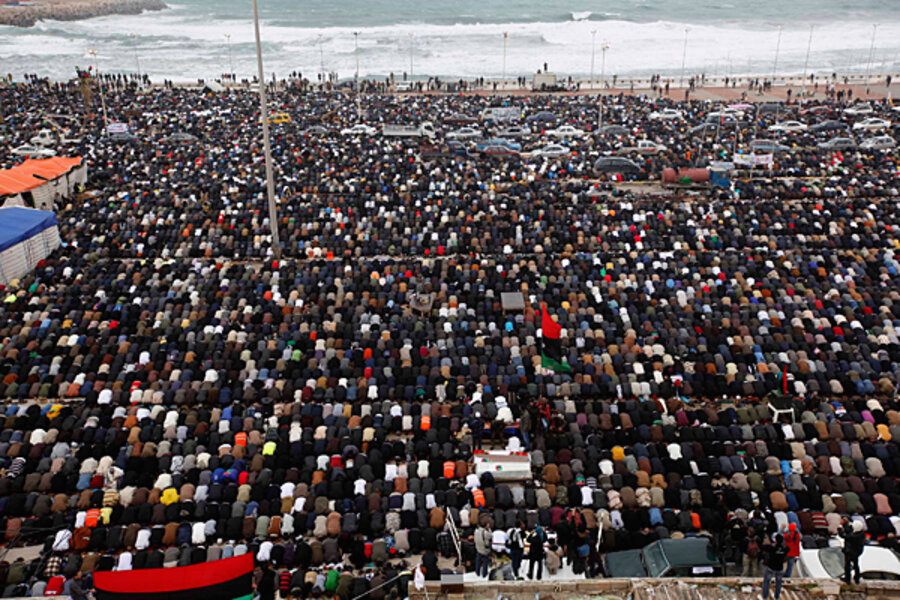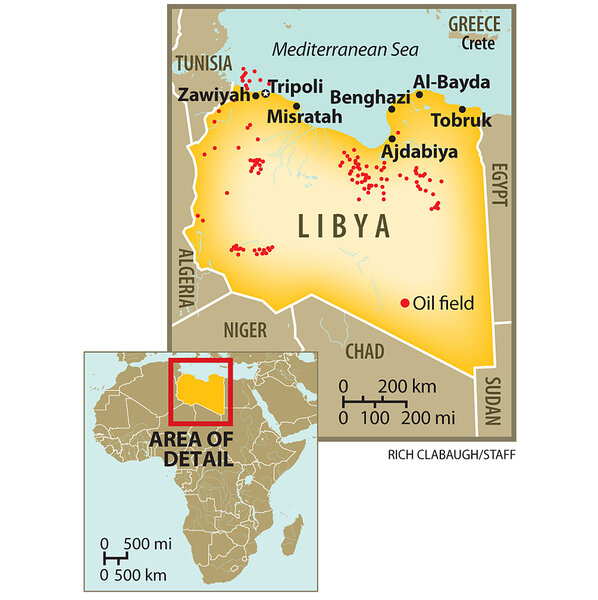Qaddafi's Plan B? 'Live and die in Libya.'
Loading...
| Benghazi, Libya
The demise of Muammar Qaddafi's regime now appears inevitable, with reports of more military bases falling to the uprising against him today and credible reports emerging that his forces have been driven out of Zawiyah, near the capital.
But he and his family still insist that they’ll try to bring down the country in flames rather than give up – a defiant stand that has sent oil prices spiking and Western countries scrambling to evacuate their citizens.
“Plan A is to live and die in Libya. Plan B is to live and die in Libya. Plan C is to live and die in Libya,” said Colonel Qaddafi’s son Saif Islam in a TV interview yesterday. Qaddafi himself, who made an appearance before cheering crowds at Tripoli's Green Square today, said on state TV that he was willing to open up his weapons caches to anyone who wants to fight on his side, and said he would set the country “aflame.”
Qaddafi faces mass defections
The Qaddafis, who today suffered another loss with the defection of their representatives to the United Nations in Geneva, seem to have positioned themselves and their supporters into a situation where they have few graceful exits available to them.
The international community, including the NATO military alliance, is holding urgent meetings to discuss possible sanctions. After rescuing US embassy staff from the besieged country, President Obama's administration today said it is moving forward with unilateral sanctions.
RELATED: Sanction Qaddafi? How 5 nations have reacted to sanctions.
In addition to a wave of Libyan diplomats who have defected from Qaddafi's regime, a number of long-time loyalists – including the interior minister – have also joined the resistance, along with high-ranking officials from the regular military and Air Force.
At least 300 civilians have been killed in clashes with pro-Qaddafi forces, though that number is certain to have risen with the violence today in and around Tripoli, enraging average Libyans.
The forces at Qaddafi's disposal
But Qaddafi appears to continue to hold sway over his Revolutionary Guards, who answer directly to him.
There are other paramilitary forces commanded by his fellow tribesmen from Sirte, roughly midway between the capital and liberated Benghazi about 500 miles east. Those from his tribe have been the principal beneficiaries of his rule, and fear of reprisals alone will probably keep them fighting.
His son Khamis Qaddafi remains in command of the 32nd Brigade, which controls the Bab al-Aziziya neighborhood in Tripoli, where Qaddafi pitches his palatial tent and many of those most reliant on his rule live.
And finally, there are the foreign mercenaries he appears to have flown in. Though their numbers are unclear, they have no community ties, and poor prospects for getting paid or flown home if their current boss loses.
That is looking increasingly likely, with the eastern third of Libya having already fallen into rebel hands and antiregime forces closing in on Tripoli.
“We’ve got good control of Benghazi and everywhere in the east now,” says Col. Khalil Daraji, an Air Force officer who is supporting the uprising. “There’s been talk of sending troops to Tripoli, but he’s still got a lot of fighters in Sirte, between here and there. And in Bab al-Azizya they’re well dug in with lots of armaments.”
A flag to make them proud
To be sure, there’s a feeling that the Qaddafi regime is already over here in Benghazi, a Mediterranean city of about 700,000.
In almost all of the east of the country now, the flag that Qaddafi introduced after he seized control of Libya in 1969 is nowhere to be seen. Instead, Libyans have replaced it with the country’s independence flag adopted after Italian colonialism ended.
Where are the previously outlawed flags coming from? “Sewing, sewing, sewing,” says Najwa Gallal. “Qaddafi likes to call his flag ‘revolutionary.’ But it was a coup, and the only revolution was giving him power. This flag reminds us to be proud.”






